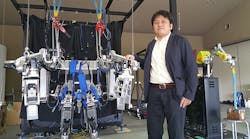NARA, Japan — If you want to find some of the more exciting exoskeleton technology in Japan and, perhaps, anywhere in the world, you have to travel a little off the popular path.
A couple hours on the famous bullet train, bound for Osaka from the metropolitan hustle of Tokyo, will get you started. Another hour on crowded highways and narrow neighborhood streets lined with gingko trees will help, too. And if you’re not sure what you’re looking for, well, it’s easy to miss the ActiveLink offices. The roof is a traditional Japanese tile, and it blends right in.
There’s no missing the thrill of potential, though, as soon as you step through the automatic sliding doors. An eight-foot-tall exoskeleton stands guard front and center, and a handful of other items are scattered around the floor. This is both a showroom and a workshop for Hiromichi Fujimoto and ActiveLink, and it is sort of incredible.
There are PowerLoader Light Ninja leg frames that strap on and can help with difficult walks or climbs, especially up mountains, in construction zones, or through the rubble of destruction. (Think about the aftermath of the country’s 2011 earthquake and tsunami.) “It can be a dangerous product if the power is too big and moves unexpectedly,” one of the company’s 16 employees, engineer Motokai Nakano, said from inside the suit, though he appeared to have mastered its pace.
There are devices that look like backpacks and act like weight belts, too, alleviating all stress from the waist and hips when lifting heavy objects. They’re designed to lessen the burden, not make you stronger — sort of like a technological steroid — and they seem perfect for factories. The company plans to roll them out in Japan, where you can rent one for as little as $420 per month, before any overseas expansion.
And there’s a power arm prototype loaded with three motors and a sensor that can measure your magnitude and force. It can lift 65 pounds with just a thumb and one or two fingers.
And then there’s that giant exoskeleton.
Fujimoto calls it the Power Effector, and it’s what draws eyeballs to every other product. During a recent morning demonstration, another engineer, Kazuma Yamaguchi, stepped up into the bicycle seat, locked in his shoes, and demonstrated its power and reach: The Power Effector’s arms extend close to seven feet and can lift more than 650 pounds, and its height allows it to move over piles. The biggest current challenge is balancing the suit: If you’re strapped in it, the burden of balance is on you, not the suit.
While not all items on the floor are ready for wide use, the future is close, and the future is exactly what Fujimoto wants.
Fujimoto founded ActiveLink 12 years ago, the physical fulfillment of a childhood dream. Before then, he had worked as an engineer for decades for Panasonic, to whom he proposed his exoskeleton idea. And long before then, he was a science fiction nerd growing up in Nara.
During his elementary and high school years in the former Japanese capital city, Fujimoto dived into the short stories and novels of Robert Heinlein — the dean of science fiction writers most famous for Stranger in a Strange Land and Starship Troopers — and watched hours of Star Trek. (He is a bigger fan of Jean-Luc Picard than James Kirk.) He fell in love with the idea of the technology in general, and exoskeletons in particular.
“I wanted to see the world I was reading about come true,” Fujimoto said. “To create a world like I saw in Star Trek, I joined Panasonic.”
Fujimoto worked for the company for more than a decade, mostly in motor research, but realized that childhood dream would never reach fruition if he remained in a corporate structure.
There are startups in Japan, but there are far more of what are called spinoffs, smaller companies pitched by the employees of large corporations who then receive VC funding from their parent company. Fujimoto presented Panasonic with his idea to develop, produce and sell power-assist suits back in 2003. He’s been at work on the technology ever since.
“They provided the capital,” Fujimoto said, “and I became the president of the company.”
ActiveLink has been profitable for the last six years, Fujimoto said, thanks to selling power-assist technology for research purposes, and for a series of R&D contract work. During ActiveLink’s early days, Panasonic said they couldn’t imagine the company being profitable, according to Fujimoto. Years later, after its first successes, many of those same officials told him, “Now, we can’t imagine how you’re making money.” Fujimoto’s nickname among his Panasonic friends and backers: The Alchemist.
There are drawbacks, of course. The company relies heavily on motors, which DARPA reportedly told Fujimoto is not practical. The lack of natural balance in the Power Effector can lengthen the learning curve, too. And there’s the fact that, like many Japanese companies, ActiveLink plans to roll out everything in Japan first before turning its eyes to the international market. (The company is at work on overseas distribution with Mitsui, which is also a minority stakeholder.)
But on a perfect Japanese morning, it’s easy to see some of what the company might have in mind. Fujimoto wants to bring more attention to his hometown, for starters, and make Nara both more of a tech hub and a tourist attraction. Mass production is planned for early 2017. Give him two years, three years, five years, and this technology could be in factories across the country and around the world, doing some of what he dreamed of as a boy.
Well, more or less. This is, after all, a little different than Star Trek.
Fujimoto is so much of a nerd at heart that he wanted to name his son after one character or another from the Star Trek universe. When that idea was swatted away, he settled for Itsuki, a character from the Japanese animated series Chapter Black Saga.
Itsuki is 11 now and interested in robotic engineering. He hangs around the office all the time, but he doesn’t want to work for his dad.
“He’s very much interested in what I’m doing,” Fujimoto said. “But he’s very intent on developing a company that competes with mine.”
Maybe he’ll be a part of the next generation.




